The use of cauldrons dates back to the Bronze Age and beyond, serving as a key possession and evolving into the medieval domestic cooking pot. For the ancient Celts, it was a symbol of wealth and hospitality, a vessel for celebrations and the finest foods they could muster. Gathered around the campfire or hung from chains in a chimney, the cauldron brought families, tribes, and communities together to feast beside the warmth of crackling flames and bubbling brew. Connections were made here, news and stories were shared, and agreements and understandings were forged. The common pot, the cauldron, held a central role around the fire.
Within the cauldron, great transformations occurred. Raw grains, meats, and vegetables turned into hearty brews and stews, nourishing and warming people from head to toe. This central figure of the household became a source of entertainment and celebration, where stories of inspiration unfolded, magic seemed to spark, and imaginations grew as wide as the eyes waiting eagerly for a second helping.
The cauldron also held a sacred place in healing. Potions made from foraged plants, herbs, and roots brought health under the watchful eye of the wise one.
One of the greatest cauldron tales of all times, tells of three magical drops that gave birth to the greatest bard, prophet, and wizard of the Celts. This stories tells of a powerful magical woman who knew all things and could transform into any beast in the blink of an eye, and of a young servant boy who absorbed ancient secrets while tending her magical pot of transformation
Many of these strange, surreal, magical tales, like those in The Mabinogion of Welsh mythology, include tales such as “The Tale of the Cauldron of Rebirth,” in which the cauldron has the power to bring the dead back to life. Stories like these are inspired by “Awen,” a Welsh, Cornish, and Breton word for “inspiration,” and give rise to further tales of “Annwn”—the other world, or land of the fairy folk—perhaps inspired by the power of those three magical drops. All the three Cauldrons of Warming, Motion, and Wisdom.

These tales, nearly lost through history with the misunderstandings and stereotypes surrounding witches, continue to be subconsciously revived wherever a pot stirs over a modern stove or open flame, alongside the sharing of inspiring, magical stories. From the kitchen stove, campfire, or theater stage, magic endures. From Shakespeare’s Macbeth, with its famous line “Double, double toil and trouble; Fire burn and caldron bubble,” to inspiring authors like J.R.R. Tolkien in The Tale of Beren and Lúthien or Roald Dahl in The Witches, tales of magic continue to influence us. Magicians who have trained in the crafts, Wizards, bards, druids, story tellers, and artists alike are custodians of this craft, creating magic with meaning.
Whether celebrated at Samhain/Halloween or any of the celebrations of the wheel of the year, the cauldron remains an alchemical cooking pot of magic, turning lead into gold, standing the test of time over sacred flames to bring us a wholesome pot of stew – transformation, healing and inspiring hope.
By Mario Morris (c) 2024


